Crucial Tips for Welders: Protecting Against Undercut Welding and Ensuring Stronger Weld Joints
In the realm of welding, achieving solid and resilient weld joints is the foundation of creating top quality job. One typical difficulty that welders frequently come across is undercut welding, which can endanger the honesty of the weld joint.

Comprehending Undercut Welding
Undercut welding is an usual welding flaw that happens when the weld metal falls short to effectively fill the groove and leads to a groove-like anxiety along the weld bead. This flaw damages the weld joint, making it susceptible to fracturing and failing under stress. Damaging can be brought on by various elements, including extreme welding current, high welding speed, incorrect electrode angle, incorrect electrode dimension, and inadequate welding technique.
One of the main reasons for undercut welding is an imbalance between the welding current and the welding speed. If the welding current is expensive or the welding rate is too quick, the weld steel might not adequately fill the groove, resulting in undercutting. Furthermore, utilizing an electrode that is also huge can cause a comparable result, as the excess steel can not appropriately flow right into the groove.
To avoid undercut welding, welders should guarantee they are making use of the proper welding specifications, preserve an appropriate electrode angle, pick the suitable electrode dimension, and method proper welding methods. By attending to these elements, welders can reduce the risk of damaging and create stronger, a lot more trusted weld joints.
Correct Welding Strategy
Effective welding strategy plays a crucial duty in guaranteeing the quality and stability of weld joints. Correct welding strategy includes a mix of adherence, accuracy, and skill to ideal methods. One basic facet of correct welding strategy is keeping the right angle and distance between the welding gun and the work surface. Welders should also pay attention to the traveling speed and warm input to avoid problems like undercutting, porosity, or incomplete blend.
Furthermore, a constant and consistent hand motion is necessary for developing solid and long lasting weld joints. Welders should go for smooth, consistent movements to make certain even distribution of the weld product. Appropriate control of the welding gun and filler material is also key to attaining optimum infiltration and blend.
Additionally, managing the heat input and picking the suitable welding criteria based upon the material being welded are important consider achieving high-quality welds - Preventing weld undercut. Welders must comply with the suggested setups given by welding treatment specifications and adjust them as required based upon the details demands of the project. By grasping correct welding techniques, welders can significantly boost the toughness and reliability of their weld joints
Choosing the Right Electrode
Maintaining the appropriate angle and range between the welding gun and the workpiece is fundamental when considering the significance of picking the appropriate electrode in welding applications. The selection of electrode plays an essential role in figuring out the quality and strength of the weld joint. Electrodes can be found in different types, each designed for particular objectives and products.
To start with, selecting the proper electrode diameter is additional hints vital. Thinner electrodes appropriate for welding thin materials, while thicker electrodes are better for thicker materials and greater heat applications. Matching the electrode diameter to the density of the workpiece assists accomplish a balanced weld.
Secondly, recognizing the material structure of the electrode is essential. Different electrodes are developed for welding particular materials like steel, stainless steel, light weight aluminum, or cast iron. Making use of the appropriate electrode material guarantees excellent fusion and lessens the threat of problems in the weld.
Last but not least, taking into consideration the welding setting and method is essential when selecting the electrode kind. For instance, certain electrodes are better suited for overhead or vertical welding placements, while others function well for level or straight positions. Choosing the ideal electrode based on the welding technique enhances the total weld top quality and stability.
Preparing the Base Metal
To guarantee an effective welding process, what initial actions should be taken when preparing the base metal for welding? In addition, any kind of existing weld product or deposit from previous welding ought to be removed to make sure a tidy surface area for the new weld.

Conducting Post-Weld Assessments

After carrying out these analyses, welders need to contrast the results against industry requirements and reference task requirements to make certain that the weld joint fulfills all needed criteria. Any inconsistencies or inadequacies uncovered during the post-weld examination ought to be without delay dealt with through proper restorative actions to ensure the weld's integrity. By faithfully doing post-weld assessments and immediately addressing any type of problems, welders can promote the top article top quality and reliability of their work, ultimately adding to the security and durability of the bonded frameworks.
Final Thought

Finally, avoiding undercut welding and making certain stronger weld joints call for a combination of appropriate welding method, selecting the ideal electrode, preparing the base metal correctly, and carrying out post-weld evaluations. By understanding the sources of undercut welding and executing the necessary preventative measures, welders can generate high-quality weld joints that meet industry requirements and guarantee the structural integrity of the bonded elements.
Undercut welding is a common welding issue that occurs when the weld steel fails to appropriately fill the groove and results in a groove-like depression along the weld grain (Preventing weld undercut). Damaging can be triggered by numerous elements, including extreme welding current, high welding rate, inappropriate electrode angle, incorrect electrode dimension, and bad welding technique
One of the major factors for undercut welding is a discrepancy between the welding present and the welding speed. If the welding current is as well high or the welding speed is too quickly, the weld metal might not properly fill up the groove, leading to undercutting.Maintaining the right angle and range between the welding weapon and the work surface is essential when taking into consideration the importance of picking the best electrode in welding applications.